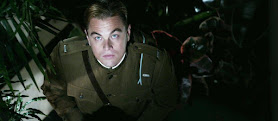When setting up a scene the director or DOP has to decide how to take the audience into the action. When deciding how to move the camera you have to first dictate the scene - considering the emotions of the characters and audience. I will be looking at 9 camera movements that the cinematographer and director collaboratively use.
The Pan means swiveling a video camera horizontally from a fixed position. It is similar to the motion of someone turning their head to look at something. Some directors use fast pans, sometimes known as whip pans to add a burst of energy and surprise whilst others use slow pans to allow the audience to take in a landscape.
The Tilt is where the camera stays in a fixed position but rotates up or down in a vertical plane. This mimics the motion of someone moving their head to look up or down when inspecting something or establishing a location. They often reveal something to us, suddenly re-directing our attention.
The Zoom involves changing the focal length of the lens to make the subject appear further or closer away, it can be used for comical effect or to add a sudden sense of urgency.
The Dolly is a smooth movement, often on a track, which moves the camera through a space. This creates a different type of visual experience than the zoom or pan. 'Vertigo' was the first film to combine the zoom and dolly movements, known as the Reverse dolly zoom or the Vertigo effect. This is used to show a character having an intense personal experience.
The Pedestal Shot moves the camera up or down, with the rotation of the camera remaining the same.
The Crane or Boom shot is an impressive movement which may also use pan and tilt. This uses an external rig such as a Jib, crane or boom pole to get unique angles (usually high) to create interesting and memorable shots.
The Steadicam or Gimbal shot can have the same effect as the dolly. However because the camera is stabilised on the camera operator the camera glides gracefully through a space.
The Handheld shot contrasts the Gimbal shot and is often shaky and disorientating. This can be used in times of suspense or disaster to show panic or add a more immersive feel for the viewer.
Lastly The Rack focus doesn't necessarily involve moving the camera and instead revolves around changing the focus of the lens from one subject to another. This is used to bring something to the viewers attention, maybe showing what a character has focused on.
Camera angles
The Eye-Level shot is pretty self-explanatory, having the camera placed at the subject's eye level. This mimics how we see people in real life, breaking down boundaries and allowing for a more personal connection between the viewer and the character.
Low-angle shots frame the subject below their eyeline. These angles are usually used to emphasise power dynamics between characters. Showing superiority. Low angle shots of one character are usually paired with high angle shots of another to show this dynamic.
In High angle shots the camera points down at the subject (above their eye level.) They are used to create a feeling of inferiority or minuity.
Some other camera angles involve shooting the subject from different levels such as: Hip Level, Knee Level, Ground level, Shoulder level. These different angles are used to outline a subjects superiority/inferiority, build relationships between character and audience, show action (like walking) and emphasise small details.
The Dutch angle or Dutch tilt is when the camera is slanted to one side. Having the horizontal lines tilted this way creates a sense of disorientation, increases the tension or an unstable mental state. It is a great way to amplify whatever emotion you are trying to bring to the scene. Overhead/Bird's eye view shots are shot from above a subject. They are usually shot rom 90 degrees above as anything lower could be considered a high angle shot. They don't have to be really high as long as they show show the subject from above. They are great for providing perspective on a scene. This perspective is usually seen as 'neutral'.
An Aerial shot whether it be shot from a drone, helicopter or plane is captured from very high up. This angle establishes a large expanse of scenery. These shots are more accessible due to the influx of drones however new rules and legislation combat this.



















No comments:
Post a Comment